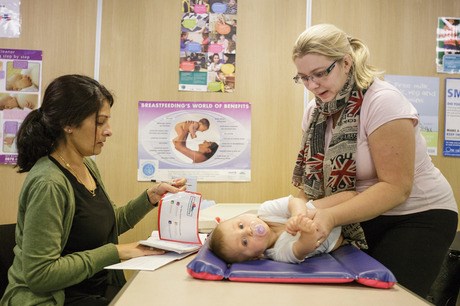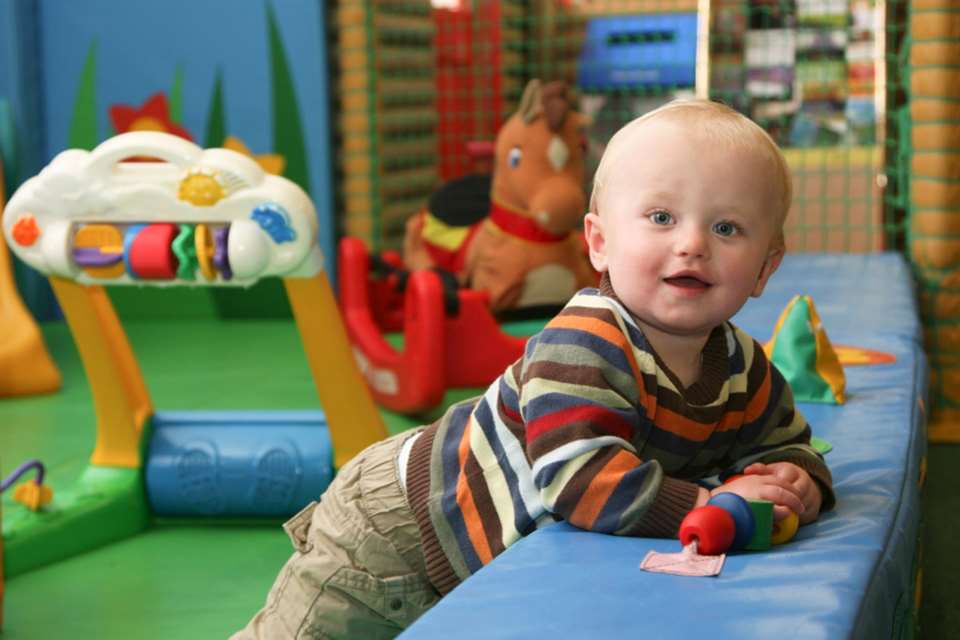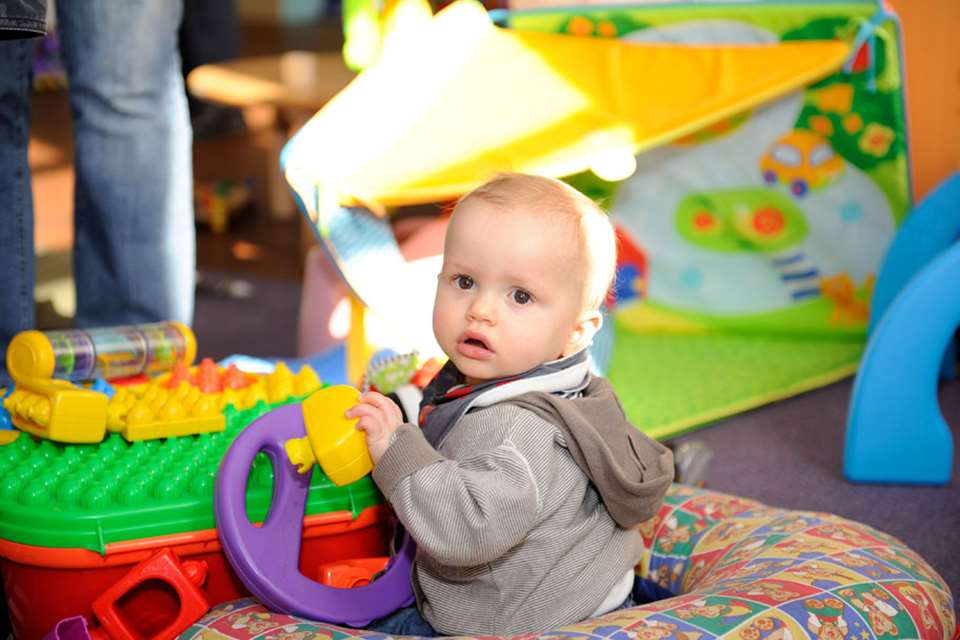EYFS Best Practice - All about... children's centres
Ruth Thomson
Monday, November 30, 2015
Budget cuts have seen the closure of many children’s centres, and reduced services at those that remain. But they are trying to forge a viable future, as Charlotte Goddard explains

On a rainy Saturday in November, hundreds of people marched through Oxford, protesting against plans to close the county’s 44 children’s centres and replace them with eight ‘family and resource centres’. Under these plans the council would stop commissioning universal services such as ‘stay and play’, and would focus instead on targeting the most vulnerable. The council says the move is driven by the need to make savings of £290m after swingeing budget cuts, while still delivering statutory services such as child protection.
It is the same story all over the country – Norfolk County Council plans to cut spending on children’s centres by more than a quarter, while Brighton & Hove City Council intends to close five children’s centres. Meanwhile, councillors in the London borough of Newham voted in September to ‘de-register’ 11 of 19 children’s centres. These venues will still be able to offer activities, but will not be Ofsted inspected.
In June, this year childcare minister Sam Gyimah announced that 99 children’s centres had closed in the first six months of 2015, with 83 closures in 2014 and 32 in 2013. More than half of these closures took place in just seven local authorities, suggesting many more may be on the cards as councils are pushed into making greater savings. 4Children’s annual report into children’s centres published earlier this year estimates that of the 3,382 children’s centre sites in existence on 30 June this year, 130 are at risk of closure.
Stay and play is the most likely service to be cut when budgets decrease
In July, Mr Gyimah announced a consultation on the future of children’s centres in Nursery World, although this is yet to start.
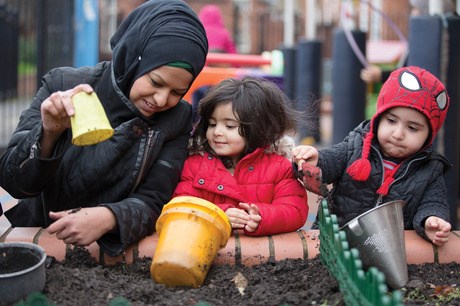
REDUCED SERVICES
Reduced funding means some managers of children’s centres are having to reduce services, or charge for services that used to be free. At the same time, there has been renewed impetus from central Government for a focus on working with the most disadvantaged, and more than three-quarters of centre managers say their work has become more targeted in the past year.
According to 4Children’s research, universal ‘stay and play’ sessions are the most likely services to be cut when budgets are decreased. But centre staff fear that cutting back on universal services will lead to problems, including difficulties in identifying those in need and the stigmatisation of children’s centre services.
‘Often services like stay and play are seen as the easier services to cut back, but they are really important in increasing parents’ capacity to parent and encouraging bonding,’ says Helen Berresford, external affairs director at 4Children.
There has also been a shift in how children’s centres are structured, explains Emily Tanner, head of children, families and work at NatCen, which has carried out extensive Government-funded research into children’s centres.
‘There has been a move from the one-stop shop towards clustering in different forms, such as the hub-and-spoke model or more general clusters,’ she says.
While these models have the advantage of pooling resources, Ms Tanner says research has shown such clusters tend to have lower-quality leadership and management. ‘We’ve also seen a thinning of provision,’ she says.
Sixty-two per cent of children’s centres were standalone in 2011, reducing to only 38 per cent in 2013. Some local authorities are turning the management of children’s centres over to schools, as in Central Bedfordshire (see right), although in other places the movement is the other way (see Islington case study).
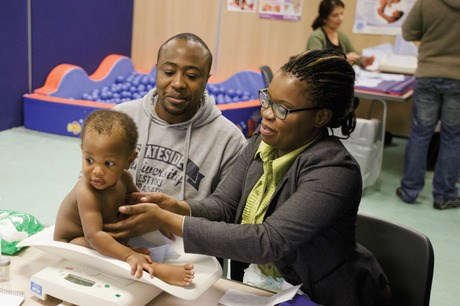
INTEGRATED SERVICES
Despite the changing backdrop, children’s centres continue to have an impact. 4Children’s research shows that more than one million children and families are using children’s centres frequently, and 77 per cent of parents who use the centres say life would be harder without them.
In some areas, the trend is towards greater integration of services around a children’s centre, particularly as local authorities took on commissioning public health services for birth to five-year-olds in October this year.
‘In Northamptonshire, our children’s centres are clustered into groups, and each area has a contractual arrangement with health partners such as midwives, health visitors, speech and language therapists, dentists and portage workers, who deliver a minimum number of 30 hours in the children’s centres or other venues accompanied by children’s centre staff,’ says Laurie Long, operational director for Action for Children in the East Midlands.
Action for Children and 4Children are separately calling for this integration to be increased across the country, with children’s centres acting as a hub for local universal services, including the funded childcare hours as well as more targeted services.
Less than half of children’s centres offer childcare since the requirement to do so was relaxed, but Kate Mulley, director of policy and campaigns at Action for Children, says that children’s centres should take on a leadership role, co-ordinating local services so that parents can access the free offer through children’s centres even if the childcare isn’t provided on-site. The future for children’s centres is uncertain, but across the country they continue to deliver support to local families against a challenging economic backdrop.
Palfrey has had a huge rise in the number of children while the number of venues has fallen
‘There has been a move from the one-stop shop towards clustering in different forms’
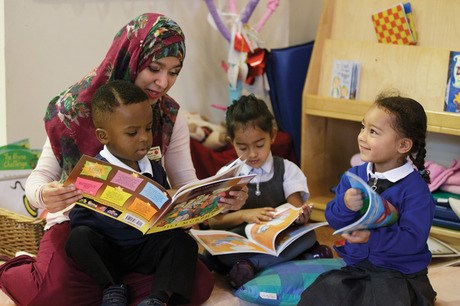
CASE STUDIES
Central Bedfordshire
From April this year, Central Bedfordshire’s nine children’s centres have been targeting the vital first year of a child’s life, when parenting support can make the most difference. The centres provides a universal service until a baby’s first birthday, with all local parents offered a postnatal parenting course, and then more targeted support.
‘All parents are offered an antenatal class, which has one postnatal session, held about six weeks after the baby is born,’ explains Sue Tyler, head of child poverty and early intervention at Central Bedfordshire Council. ‘Children’s centre staff now tell the parents about the postnatal course, which covers issues such as behaviour, sleep, vaccinations, establishing routines, and childcare.’
Each centre will offer about six courses a year, with up to 24 attendees on each. ‘We run them in the daytime, but are thinking about evenings as well,’ says Ms Tyler. ‘We are finding that the attendees are carrying on meeting as little groups, building up their own support network after the course has finished.’
The universal offer also includes other services such as Baby Brasseries, cafe-style drop-in sessions to encourage breastfeeding. ‘After the end of the first year, hopefully we will have identified the parents in need and the children’s centre will continue working with them, perhaps signposting them to other services such as Parent Puzzle,’ says Ms Tyler.
‘There is no closed door beyond the first year – if a parent says they are lonely the children’s centre will be available for them – but we no longer have to go out and engage parents who are quite capable of finding toddler groups on their own.’
Central Bedfordshire’s children’s centres were reduced from 22 to nine between 2010 and 2012, with the nine surviving centres now covering a wider area. Schools are playing a larger role in the management of the centres – seven of the nine are now run by schools, and the other two are run by the YMCA. ‘Schools are incredibly well placed to influence their community, and will often be able to identify issues early, through knowledge of siblings, for example,’ says Ms Tyler.
As part of a later wave of children’s centres, the settings have never offered childcare, although some have pre-schools on the same site. But they are playing a major part in making sure local disadvantaged two-year-olds take up their funded hours, as part of Central Bedfordshire’s multi-pronged approach.
‘The Department for Education sends out a list of all the parents who are eligible, and after three weeks the list has to be destroyed,’ says Ms Tyler. ‘We reached an agreement that we could share that list with the children’s centres as long as they also promised to destroy it. If the family is already known to the centre, they ring up and say the time has come; if not, they go to talk to them –the centres have good relationships with daycare providers so can support parents in taking up the offer.’ The council also sends eligible parents of two-year-olds Bookstart vouchers that can only be redeemed at the children’s centre, encouraging them through the doors.
Some charities are calling for children’s centres to act as hubs for local universal services
Sure Start Palfrey, Walsall
Mick Davies, manager of Sure Start Palfrey children’s centre, believes the past year has been one of the most trying since the centre began delivering services to local families 13 years ago. ‘Our budget has been cut by £250,000 from what it was at its highest,’ he says. ‘We have had to lose frontline staff, including the children’s centre teacher, a couple of early years workers and a family support worker.’ At the same time, the closure of other centres in Walsall means the number of children Palfrey serves has risen from 682 to more than 2,000, while the number of venues it delivers services out of has fallen from 21 to four or five.
Despite all of this, Palfrey was rated ‘outstanding’ by Ofsted for the second time this summer. ‘We continue to soldier on and deliver what we can,’ says Mr Davies. Services have changed over the years to reflect the shifting demographics in the local community, and the centre has worked particularly hard to engage fathers. ‘We have found that running ‘family activities’ rather than ‘dads’ activities’ on a Saturday gets dads out more,’ says Mr Davies.
Strong links with the local community help the centre to deliver its services – Mr Davies says many of the staff have been part of the 16-strong team since the centre opened, and most live or were born in the area it serves.
‘Our community is reflected in our team,’ says Mr Davies. ‘It was mainly an Asian area and the majority of residents were Muslim. We have now noticed more of an Eastern European community, and our latest family support worker, who has been with us for four years, is Polish.’ He says budget cuts have meant less outreach work, but the team still ‘knock on doors’ to engage new parents, rather than delivering letters.
The children’s centre does not offer childcare on-site, but has strong links with Palfrey Day Nursery, managed by Palfrey Community Association. Other services run by Sure Start Palfrey include Baby Space, offering arts-based activities in partnership with an outside agency, stay and play sessions and toddler groups, baby massage, baby yoga, breastfeeding support and sessions on sleep management, potty training and speech development.
Mr Davies has concerns about the direction of Government early years policy, and its impact on children’s centres. ‘The move from Every Child Matters and preventative, universal services to more of an emphasis on individual families and targeted parenting courses is something we are fighting against,’ he says. ‘The people who make decisions about budgets think universal services are just parents playing with their kids, but all our activities have a purpose, and are planned.’
Packington Children’s Centre, Islington
As a phase two children’s centre, opening in 2008, Packington’s support for local children and families has always put importance on quality childcare. The centre, which recently gained its second outstanding rating from Ofsted, more than doubled its childcare offer from 30 to 68 full-time places earlier this year, when it took over a local nursery. ‘There is high local demand, and we offer childcare from 8am to 6pm on both sites,’ says centre manager Ana Sevilla.
The community that Palfrey serves is reflected in its team
Packington now operates out of two nursery sites and a community hub, and the childcare element is an integral part of the centre’s services, says Ms Sevilla. ‘Some staff work across all three sites, including family support workers, the special educational needs co-ordinator, staff supporting speech and language, and those running stay and play sessions,’ she says. ‘Because we have more than one site, it is very important we are one team.’ Recruitment is an issue, and the centre is still trying to find suitable qualified staff for its new nursery site.
The introduction of fun-ded hours for eligible twos has enabled the team to identify children’s needs earlier and link them with the centre’s other support services. ‘We have noticed an increase in families experiencing domestic violence and with mental health issues and speech and language delay,’ says Ms Sevilla. ‘We also share our resources and specialist staff with other settings within our catchment area to ensure the support is where the child and family are.’
Packington was originally a children’s centre in a school, but became a standalone centre in 2012. As well as its three sites, the team run services such as stay and play groups from a number of community venues, including church halls, community centres and a hostel.
‘We saw that families in the hostel, many of whom are fleeing domestic violence or have mental health issues, were not taking up services from the centre,’ explains Ms Sevilla. ‘So we started to offer sessions with our speech and language therapist and CAMHS (child and adolescent mental health services) worker in the hostel, where we were already offering a stay and play group.’
Ms Sevilla has worked at Packington Children’s Centre since it opened in 2008, and says that thanks to support from Islington Council the centre has not seen a drop in funding, and has managed to retain all the services it started out with, the majority of which are open access. These include support for young parents, helping parents into work, antenatal and postnatal clinics and Chatterpillars, a speech and language support group.
‘We are very fortunate that Islington Council is committed to providing quality services for children and families,’ she says. ‘I don’t know what the future is going to look like but there have always been challenges in this field.’
Clayton Brook Children’s Centre, Lancashire
In common with local authorities across England, Lancashire County Council is gearing up for huge public sector savings. Angela Braithwaite, centre co-ordinator at Clayton Brook Children’s Centre, fears for the survival of the setting.
Clayton Brook, rated ‘good’ in its last Ofsted inspection, is attached to a local primary school, with which it is able to share resources. It employs eight staff, delivering a mixture of open-access and targeted services both from its own building and in seven schools, six nurseries and other venues across the community. Speech and language work is a key aspect of the centre’s work, and a speech and language therapist is employed for one day at the centre, and another day at the school, and supported by an assistant.
‘We are often working with children who don’t meet the criteria for NHS treatment,’ says Ms Braithwaite. ‘We plug the gap. We are able to catch issues early and children are able to start school with a programme already in place.’ The support that the centre offers includes one-on-one work with the speech and language therapist and groups such as the six-week Chatterbox sessions.
Other services offered by the centre include music and movement sessions, parent support groups covering issues such as weaning and first aid, a group for Polish parents – a growing demographic locally, and messy play sessions. Local obesity rates are rising, and the centre recently introduced a ten-week cookery course for parents who had been identified as needing extra support in maintaining healthy diets for the whole family. This has been further supported with the Healthy Heroes cooking group for both children and parents and physical activity sessions. Open-access sessions deliver information to parents on issues such as behaviour management, sleep and domestic violence.
‘Our strength is early intervention,’ says Ms Braithwaite. ‘And supporting families through difficult periods before they escalate to more serious concerns, easing pressure on social care interventions.’
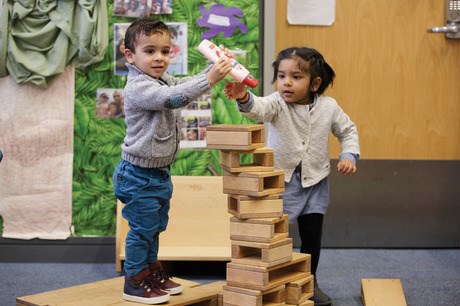
CHILDREN’S CENTRES: FACTS AND FIGURES
55.2 per cent of parents said they used their local children’s centre at least once a week.
90.5 per cent of parents said that attending a children’s centre has had a positive impact on their child.
79.4 per cent of parents said that if they were unable to use their local children’s centre this would make life harder for them and their family – 34.4 per cent of parents said it would make a ‘big difference’ and life would become ‘a lot more difficult’.
More than one million children and families are regularly using children’s centres, with a majority of centre managers saying that numbers have gone up in the past 12 months.
57.5 per cent of managers who have experienced a budget reduction say they will have to cut back services as a result and 32 per cent say they will be unable to reach as many families as before.
24.5 per cent of managers know changes will be made to the way their children’s centres are run in the next year, but do not know what this will involve.
Source: Children’s Centre Census 2015, 4Children
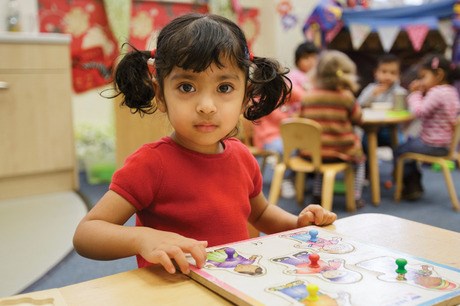
More information
Beyond the Building series on challenges for children’s centres, Action for Children, www.actionforchildren.org.uk/resources-and-publications/reports/beyond-the-building-children-s-centres-briefing-series
Children’s Centre Census 2015, 4Children, www.4children.org.uk/Files/28082f59-4cb8-4116-a476-a536009e5d05/Children_Centre_Census_2015.pdf
Evaluation of children’s centres in England, NatCen, www.natcen.ac.uk/our-research/research/evaluation-of-children%E2%80%99s-centres-in-england
